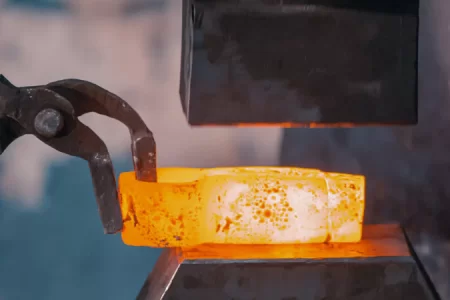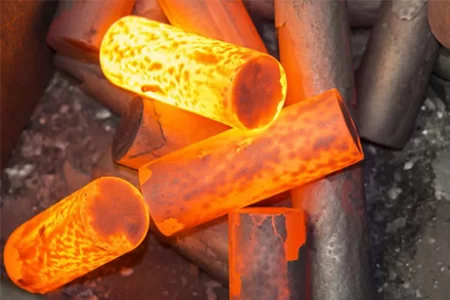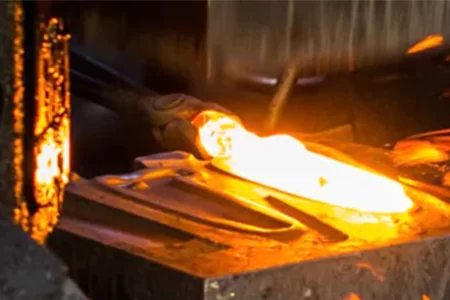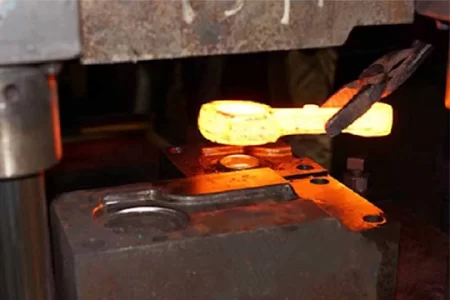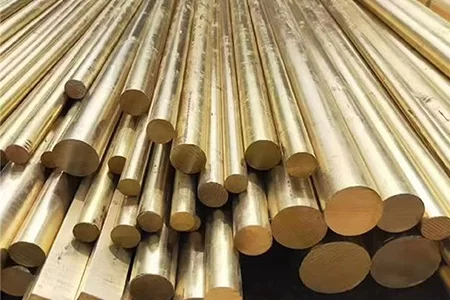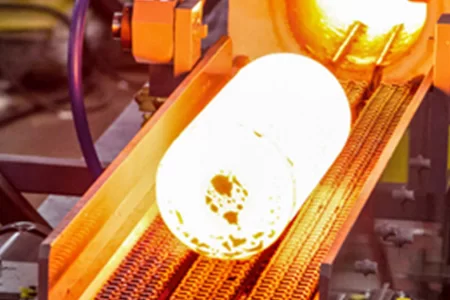HULK Metal will continuously update the dynamics of the metal products industry, to support your decision-making.

Hulk Metal News
Share what's new
-
Home>
-
Blog>
-
Technology>
Mining Parts Supplier's Mining Parts Forging Technology Analysis: Process, Materials and Quality Control

Mining parts forging is a very important part of the mining industry, involving a variety of complex manufacturing processes and technologies. As a hot forging manufacturer, we are well aware that in the manufacturing of mining parts, high-quality forging products are not only crucial to the performance of the equipment, but also have a profound impact on safety, durability, and economy. This article will comprehensively explore all aspects of mining parts forging, including its importance, forging process, common forging materials, heat treatment technology, and its application in mining parts, and strive to provide readers with an in-depth and complete understanding.
The Importance of Mining Parts Forging
Mining parts are indispensable equipment in the process of mineral resource mining, including crushers, ball mills, belt conveyors, drills, buckets, grabs, etc. These equipment usually need to withstand high-intensity impact, wear and high-temperature operating environments, so the quality requirements for their components are extremely strict.
As an important process in the manufacturing of mining parts, forging has the advantage of being able to compress raw metal materials to make their grains more closely arranged, thereby improving the mechanical properties of the material. Through the forging process, key components of mining parts such as gears, bearings, valves, etc. can obtain higher strength, hardness, wear resistance, and impact resistance, thereby ensuring the long-term stable operation of equipment in harsh environments.
Forging requirements of key components
Many key components of mining parts, such as transmission shafts, gears, support shafts, racks, etc., need to be manufactured by forging. In particular, for some components that need to withstand extremely large mechanical loads, the use of forging technology can effectively improve their compression, torsion, tensile, and fatigue resistance, and avoid equipment failure or shutdown caused by material defects, thereby improving overall production efficiency and reducing maintenance costs.
Environmental requirements for mining parts
Mining parts often work in extremely harsh environments, such as high temperature, high pressure, high impact, severe corrosion, etc., which requires mechanical parts to have good fatigue resistance and wear resistance. The forging process can improve these characteristics by changing the internal structure and performance of the material, ensuring that mining parts can operate stably under extreme conditions.
Basic principles and processes of the forging process
Hot forging is a process in which metal is heated to above its recrystallization temperature and external force is used to cause it to undergo plastic deformation. The forging of mining parts usually adopts hot forging process, and the specific process includes the following steps:
Material selection
The selection of forging materials is the first step in the forging of mining parts. Usually, the appropriate steel grade is selected according to the functional requirements of the required parts. For example, transmission parts may require high-strength alloy steel, while some wear parts may require wear-resistant steel. Choosing the right raw material is crucial to the quality of forgings.
Material preheating
During the forging process, the material must be heated to a certain temperature range to improve its plasticity. For most alloy steels, the forging temperature is usually between 1000℃ and 1200℃. In this temperature range, the metal has enough plasticity and can be easily formed by the die.
Forging molding
During the forging process, the raw material is formed by die pressing, hammering or extrusion, usually using different forging methods such as free forging, die forging, and closed die forging. Mining parts usually require precision dies and special forging equipment due to their complex shapes.
Cooling treatment
After forging, the parts need to be cooled slowly. The control of cooling rate has an important influence on the microstructure and performance of forgings. Too fast or too slow cooling may cause internal stress, deformation, or coarse grains in forgings.
Common forging materials and their applications
In the forging process of mining parts, commonly used materials include carbon steel, alloy steel, stainless steel, and some special wear-resistant materials. The choice of each material depends on the use environment and requirements of the forging.
Carbon steel
Carbon steel is a steel with a high carbon content and is widely used in some structural parts in mining parts. It has good strength and toughness, but poor wear resistance and corrosion resistance, so it is usually used for parts with less severe loads.
Alloy steel
Alloy steel is made by adding different alloying elements to enhance the properties of steel. Common alloying elements include chromium, molybdenum, nickel, etc. Alloy steel is usually used to manufacture parts that bear large loads or work in high-temperature and high-pressure environments, such as gears, bearings, and racks.
Stainless steel
Stainless steel has good corrosion resistance and is suitable for some mining parts that need to withstand corrosive substances or high-humidity environments, such as pump bodies and valves.
Special wear-resistant steel
Many mining parts need to have strong wear resistance, especially those parts that are in direct contact with ore, such as the liner and bucket of the crusher. Special wear-resistant steel, such as high manganese steel, chrome-molybdenum steel, wear-resistant alloy steel, etc., can significantly improve the service life of parts.
Application of heat treatment technology in forging
Heat treatment technology plays a key role in optimizing the performance of forged parts of mining parts. Through a reasonable heat treatment process, the hardness, wear resistance, strength, and fatigue resistance of forgings can be significantly improved.
Normalizing
Normalizing is the process of heating forgings to a certain temperature and cooling them in the air. It is usually used to refine grains and improve the strength and toughness of forgings. For parts in mining parts that bear heavy loads, normalizing treatment helps to increase their service life.
Quenching and tempering
Quenching is to heat the forgings to the austenite zone and then quickly cool them to form a martensitic structure with higher hardness. Tempering is to reheat the forgings appropriately after quenching to eliminate internal stress and obtain better toughness. Quenching and tempering are often used to improve the wear resistance and impact resistance of mining parts.
Carburizing and nitriding
Carburizing and nitriding are heat treatment processes commonly used to improve surface hardness. They are suitable for parts that require surface wear resistance but need to maintain toughness inside. These two processes are often used for parts such as gears and bearings.
Quality control of mining parts forging
Mining parts forging has very strict quality requirements, so strict quality control must be carried out throughout the forging process. The key links of quality control include raw material testing, forging process monitoring, heat treatment process control, and final testing and inspection.
Raw material testing
Before forging, the raw materials must be strictly tested, including chemical composition, mechanical properties, surface defects, etc. By ensuring the qualification of the raw materials, water quality problems caused by material problems can be avoided.
Forging process monitoring
Key parameters such as temperature, pressure, and forming process need to be monitored in real-time during the forging process. The use of advanced equipment, such as temperature monitors, pressure sensors, laser scanning, etc., can ensure the stability and consistency of the forging process.
Heat treatment process control
The parameters of the heat treatment process, such as heating temperature, cooling rate, tempering temperature, etc., need to be strictly controlled. After heat treatment of each batch of forgings, metallographic analysis, hardness test, etc. are carried out to ensure that the heat treatment effect meets the standard.
Final inspection
After the forging is completed, the final size inspection, appearance inspection, mechanical property test, etc. must be carried out to ensure that it meets the design requirements. Potential internal defects can be found through non-destructive testing (such as ultrasonic testing, magnetic particle testing, etc.).
Mining parts forging plays a vital role in the entire mining industry. Through precise material selection, advanced forging technology, and strict quality control, it can produce high-performance parts that meet the requirements of extreme working environments. The hot forging process not only improves the strength, wear resistance, and impact resistance of mining parts, but also effectively extends the service life of equipment, reduces maintenance costs, and improves production efficiency. In the manufacturing process of mining parts, we combine advanced heat treatment technology and innovative material science to continuously optimize forging technology, providing a strong guarantee for the efficient operation of mining equipment.
With the continuous upgrading of industry demand, the manufacturing of mining parts is also moving towards higher precision, higher efficiency,y, and more environmental protection. Intelligent and automated production equipment gradually replaces traditional manual operations, which not only improves the flexibility and efficiency of production but also enhances the accuracy and consistency of the forging process. In the future, with the continuous advancement of technology and the innovation of manufacturing concepts, the forging process of mining parts will further develop in the direction of high performance and high reliability, providing more solid technical support for the sustainable development of the global mining industry.
Therefore, as a manufacturer of mining parts forging, HULK Metal will continue to deepen technology research and development, improve production capacity, strictly control every manufacturing link, provide customers with more excellent and reliable products, and promote technological progress and innovative development in the industry.
Article Navigation
Article Navigation
Industries
Foundries
-

July.01, 2024
Difference between hot forging and cold forging
READ MORE
-

June.27, 2024
What are the advantages and disadvantages of the hot forging process?
READ MORE
-

January.18, 2024
Forging: What Is It? What Are The Different Types of Hot Forging?
READ MORE
-

November.29, 2024
What is steel forging?
READ MORE
-

July.30, 2024
What are the materials for hot forging?
READ MORE
-

July.03, 2024
What are the processes of hot forging?
READ MORE



